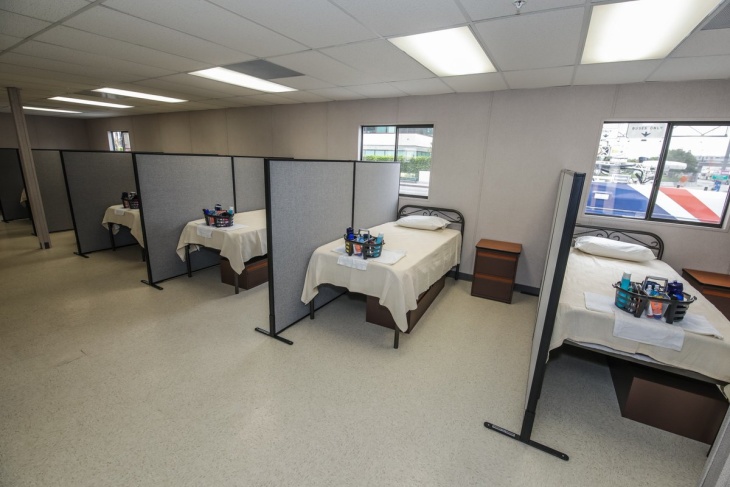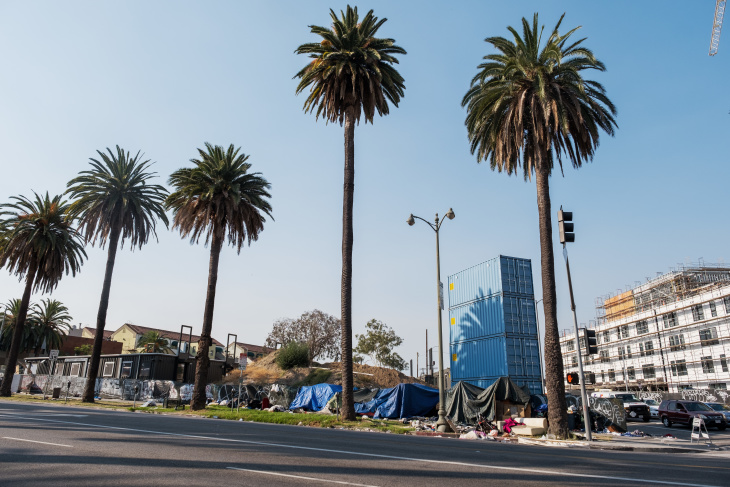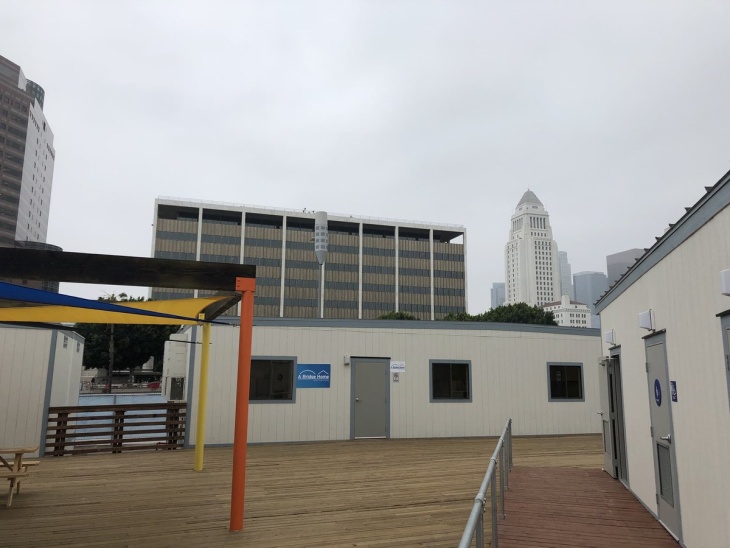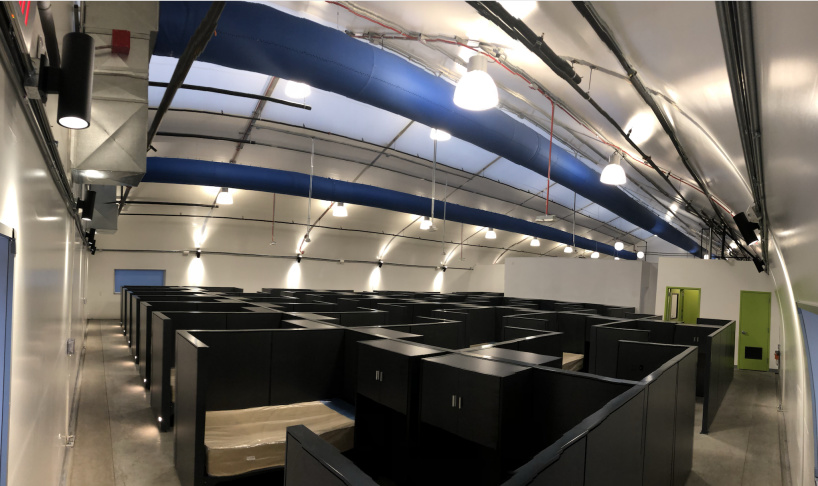
Our news is free on LAist. To make sure you get our coverage: Sign up for our daily newsletters. To support our non-profit public service journalism: Donate Now.
On a cloudy September morning almost two years ago, a who's who of L.A.'s political and social services elite gathered downtown near Union Station to inaugurate the very first temporary homeless shelter attached to L.A. Mayor Eric Garcetti's "A Bridge Home" program.
"We can't just keep people alive on the streets. We can't just wait for that day in which they will have a permanent apartment. We have to do something today; a place to start healing," said L.A. Mayor Eric Garcetti, at the event.
Two years later, despite initial resistance from local residents in Koreatown, Venice, and beyond, L.A. has completed 22 of these shelters across the city. Thirteen have come online so far in 2020, and the program has netted a total of 1,766 new beds.
L.A. has currently invested approximately $187 million into the program, the majority of the funding coming from the State of California through its HEAP and HHAP programs.
STEADY STREAM
Garcetti and other politicians pitched the shelters as an interim solution — a place for people experiencing homelessness to recover from the trauma of living outside before moving into permanent housing.
Unlike most shelters, bridge housing residents are allowed to remain at the site 24/7, where they have access to three meals a day, healthcare, and a caseworker. That allows residents a level of stability that's impossible to find while outside.
At several ribbon cuttings this summer, Garcetti underscored how residents would quickly exit to permanent housing, allowing beds to be "recycled" over and over again.
He painted a portrait of efficiency: a steady stream of people entering and exiting as they moved on, thanks to the dedicated work of social workers helping them find long-term places to live.
The reality, however, is less straightforward.
RESULTS SO FAR

When 'A Bridge Home' first launched, the initial goal was that residents would remain at those interim sites for about three months before moving into permanent housing.
But results from the first four sites that have been open for more than a year show residents are not departing for permanent housing in the volume politicians had hoped they would.
At El Puente, the first site that opened, only 35 people have moved on to permanent housing over the past two years, out of a total 117 served, according to John Maceri, who directs the agency in charge of that site, The People Concern.
Maceri said that of the rest, 33 people left for another interim housing facility, or returned home to their families. Nine people voluntarily left the program, eight were arrested and incarcerated, 20 were asked to leave for inappropriate behavior, and 12 were hospitalized and needed a higher level of care.
Maceri underscored that finding housing that can meet the needs of people who have experienced years of trauma from living outside is, by its nature, difficult and time intensive. He said the results from the El Puente site are consistent with results across L.A.'s homeless services system.
"As we knew from the beginning, finding available, affordable housing units was going to always be a challenge," said Maceri.
"The residents of El Puente mirror what we see in our general homeless population. We see a high level of disability, both in terms of chronic health conditions, as well as mental illness and substance addiction. And I say this not because it lends itself to the program being less effective or more effective. It just is."
LOWER AND SLOWER
At three "A Bridge Home" sites operated by People Assisting The Homeless (PATH), about 24% of program exits have been to permanent housing, according to Jennifer Hark-Dietz, PATH's executive director.
- At the 72-bed Schrader Boulevard site in central Hollywood, which has been open since March 2019, there have been 105 discharges, but only 28 permanent housing placements.
- At the 124-bed Y.W.C.A. location in Hollywood, which opened in two phases in November 2018 and February 2020, there have been only 24 permanent housing placements among 101 discharges.
- The 41-bed Casa Azul Boulevard location in Westlake, which opened in May 2019, has seen 13 permanent housing placements from 63 total discharges.
In July at the opening of a bridge housing shelter in San Pedro, Mayor Garcetti acknowledged that transitions out of "A Bridge Home" sites into housing had been fewer than anticipated, and were taking more time.
"It's lower and slower is the honest answer. We'd been hoping it would be every three or four months .. six months. In the first ones it was averaging more like a year," Garcetti said.
Getting a comprehensive set of numbers for the program's results has been difficult. LAist has made multiple requests since July, but the Mayor's office has been unable to provide that information.
Garcetti's press secretary, Alex Comisar, said the data was hard to put together because it's gathered at the provider level, not the city level.
He also added that the Mayor's office evaluates the program's success by "how many beds we're putting on line," as distinct from how many people transition into permanent housing.

THE PERPETUAL BOTTLENECK
If the street is on one side of a bridge shelter, permanent housing is on the other. Or at least, it should be.
But that depends on low-income housing being available. And more often than not in Los Angeles, there just isn't very much.
L.A.'s homeless services system relies on social workers helping people who are homeless to grow their monthly income so they can afford a place to live.
That means connecting them with rental vouchers, income subsidies, and other public assistance programs.
But even that isn't enough to afford the high cost of rent in most buildings, causing a perpetual bottleneck.
The result is a system that leaves every individual (and their case manager) jockeying for a very small number of affordable housing slots or rental subsidies in a perverse game of musical chairs.
Everybody in the system — whether they're on the street, in bridge housing, in a hotel, or in any of the myriad of other temporary housing 'solutions' provided by L.A.'s homeless services system — is competing for the same small number of spaces.
Many people get stuck, even with a case manager and connections to social services.
Hark-Dietz says bridge housing provides a major service, but she's worried that it can become a destination for many, not a quick stopover.
"We have to still focus on the outcomes and on the outflow into permanent housing so we can continue to use [bridge housing] as a resource, and not necessarily just a space where people are living long-term," said Hark-Dietz, of PATH.
RELIEF ON ITS WAY
In July, Mayor Garcetti speculated that things will move more quickly looking forward because additional permanent housing will come online thanks to Proposition HHH.
That's the $1.2 billion bond measure that Los Angeles voters passed in 2016 to subsidize the construction of thousands of units of low-income housing. Dozens of projects, each with hundreds of apartments, are anticipated to open over the next two years, although only two buildings totaling 106 units have opened so far.
When those buildings do start opening, it's hoped they will relieve some of the built-up pressure.
"I think, you know, the end of this year and early next year, we'll start to see a wave of several thousand [units] coming online which will help. Nothing is going to be the magic bullet, but we'll start to see momentum," said Maceri of The People Concern.
WHAT'S NEXT?
In the meantime, Los Angeles is poised to radically expand its stock of interim housing, including bridge housing. That's because of a federal lawsuit that alleges Los Angeles has handled mass homelessness with negligence. In June, the City of L.A. agreed to rapidly provide shelter for more than 6,000 people by April of 2021.

Precisely how the city will produce 6,000 new shelter beds in the next eight months is still obscure. Some of those beds will be in previously planned "A Bridge Home" sites, though court documents indicate many beds may come in the form of tiny homes, hotel rooms, rented apartments, or safe-parking and sanctioned camping locations on public land.
Maceri worries that more shelter beds means more people living long-term in congregate shelter settings, which are not a substitute for housing.
"I don't think we should take the approach that all the money should be invested in just emergency or bridge housing without an exit strategy. Because then what we're doing is we're essentially warehousing people indefinitely," said Maceri.
"And I know the argument is better for people to be in some kind of temporary situation than to be on the street. And I agree that it is. Some shelter is better than no shelter. But some shelter without a clear exit strategy is not a good plan."
"Exit" - Google News
August 25, 2020 at 05:51AM
https://ift.tt/2YucyVB
A Bridge To Where? Few Exit LA's 'Temporary' Homeless Shelters For Permanent Housing - LAist
"Exit" - Google News
https://ift.tt/2zNkU0N
https://ift.tt/2YrnuUx
Bagikan Berita Ini














0 Response to "A Bridge To Where? Few Exit LA's 'Temporary' Homeless Shelters For Permanent Housing - LAist"
Post a Comment